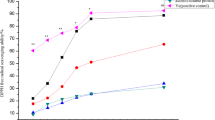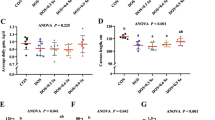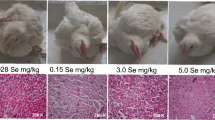Abstract
To elucidate the influence of methionine on the endogenous antioxidant activity of rice protein (RP), growing and adult rats were fed with RP and methionine-supplemented RP (RM). After 2 weeks feeding, hepatic contents of ROS were significantly reduced by RP and RM. The endogenous antioxidant responses were induced by RP and increased by RM, in which methionine sulfoxide reductases (MsrA, MsrB2, MsrB3) expression and glutathione synthesis were uniformly stimulated and up-regulated with increasing consumption of methionine. With the intake of RP and RM, Nrf2 was activated through depressing Keap1 and Cul3, resulting in the up-regulation of antioxidant-responsive element (ARE)-driven antioxidant expressions (GCLC, GCLM, CAT, SOD, HO-1, NQO1) with increasing dietary level of methionine. The present study demonstrates that methionine can augment the endogenous antioxidant activity of rice protein, which is primarily attributed to stimulating methionine sulfoxide reductases expression and enhancing glutathione synthesis via Nrf2-ARE pathway. Results suggest that the methionine availability might play a key role in inducing and augmenting the endogenous antioxidant response exerted by rice protein, which is independent of age.







Similar content being viewed by others
References
Zhang J, Zhang H, Wang L, Guo X, Wang X, Yao H (2009) Antioxidant activities of the rice endosperm protein hydrolysate: identification of the active peptide. Eur Food Res Technol 229:709–719
Adebiyi AP, Adebiyi AO, Hasegawa Y, Ogawa T, Muramoto K (2009) Isolation and characterization of protein fractions from deoiled rice bran. Eur Food Res Technol 228:391–401
Adebiyi AP, Adebiyi AO, Yamashita J, Ogawa T, Muramoto K (2009) Purification and characterization of antioxidative peptides derived from rice bran protein hydrolysates. Eur Food Res Technol 228:553–563
Li H, Yang L, Yang H, Sun S, Liu H, Wu Q, Chen J, Zhuang T (2014) Rice protein regulates HDL metabolism-related gene expression and enzyme activity in adult rats. Food Biosci 8:1–7
Yang L, Chen JH, Zhang H, Qiu W, Liu QH, Peng X, Li YN, Yang HK (2012) Alkali treatment affects in vitro digestibility and bile acid binding activity of rice protein due to varying its ratio of arginine to lysine. Food Chem 132:925–930
Yang L, Chen JH, Xu T, Nie MH, Yang HK (2013) Hypocholesterolemic effect of rice protein is due to regulating hepatic cholesterol metabolism in adult rats. Gene 512:470–476
Yang L, Chen JH, Xu T, Zhou AS, Yang HK (2012) Rice protein improves oxidative stress by regulating glutathione metabolism and attenuating oxidative damage to lipids and proteins in rats. Life Sci 91:389–394
Cai J, Yang L, He HJ, Xu T, Liu HB, Wu Q, Ma Y, Liu QH, Nie MH (2014) Antioxidant capacity responsible for a hypocholesterolemia is independent of dietary cholesterol in adult rats fed rice protein. Gene 533:57–66
Métayer S, Seiliez I, Collin A, Duchêne S, Mercier Y, Geraert P-A, Tesseraud S (2008) Mechanisms through which sulfur amino acids control protein metabolism and oxidative status. J Nutr Biochem 19:207–215
Lu SC (2013) Glutathione synthesis. Biochim Biophys Acta 1830:3143–3153
Lu SC (2009) Regulation of glutathione synthesis. Mol Asp Med 30:42–59
Lee BC, Gladyshev VN (2011) The biological significance of methionine sulfoxide stereochemistry. Free Radic Biol Med 50:271–277
Lee BC, Dikiy A, Kim HY, Gladyshev VN (2009) Functions and evolution of selenoprotein methionine sulfoxide reductases. Biochim Biophys Acta 1790:1471–1477
Liu Y, Wang Z, Li H, Liang M, Yang L (2016) In vitro antioxidant activity of rice protein affected by alkaline degree and gastrointestinal protease digestion. J Sci Food Agric 96:4940–4950
Wang Z, Liu Y, Li H, Yang L (2016) Rice proteins, extracted by alkali and α-amylase, differently affect in vitro antioxidant activity. Food Chem 206:137–145
Wang Z, Li H, Liang M, Yang L (2016) Glutelin and prolamin, different components of rice protein, exert differently in vitro antioxidant activities. J Cereal Sci 72:108–116
Li H, He H, Wang Z, Cai J, Sun B, Wu Q, Zhang Y, Zhou G, Yang L (2016) Rice protein suppresses ROS generation and stimulates antioxidant gene expression via Nrf2 activation in adult rats. Gene 585:256–264
Nguyen T, Nioi P, Pickett CB (2009) The Nrf2-antioxidant response element signaling pathway and its activation by oxidative stress. J Biol Chem 284:13291–13295
Atmaca G (2004) Antioxidant effects of sulfur-containing amino acids. Yonsei Med J 45:776–788
Yang L, Kadowaki M (2011) Addition of methionine to rice protein affects hepatic cholesterol output inducing hypocholesterolemia in rats fed cholesterol-free diets. J Med Food 14:445–453
Balkan J, Doğru-Abbasoğlu S, Çevikbaş U, Aykaç-Toker G, Uysal M (2004) Methionine supplementation did not augment oxidative stress, atherosclerotic changes and hepatotoxicity induced by high cholesterol diet in C57BL/6J mice. J Nutr Sci Vitaminol 50:258–264
Moundras C, Rémésy C, Levrat MA, Demigné C (1995) Methionine deficiency in rats fed soy protein induces hypercholesterolemia and potentiates lipoprotein susceptibility to peroxidation. Metabolism 44:1146–1152
Li H, Wang Z, Liang M, Cai L, Yang L (2018) Methionine augments antioxidant acitivity of rice protein during gastrointestinal digestion. Int J Mol Sci 20:868
Zhang Y, Xu S, Jin H, Wang R, Peng Z (2015) Influence of selenium and methionine intake of the female chicken on lipid oxidation in the thigh muscles of progeny. Eur Food Res Technol 240:83–91
Brosnan JT, Brosnan ME (1640S) The sulfur-containing amino acids: An overview. J Nutr 136:1636S–1640S
Brosnan JT, Brosnan ME, Bertolo RFP, Brunton JA (2007) Methionine: A metabolically unique amino acid. Livest Sci 112:2–7
Martinov MV, Vitvitsky VM, Banerjee R, Ataullakhanov FI (2010) The logic of the hepatic methionine metabolic cycle. Biochim Biophys Acta 1804:89–96
McBean GJ (2012) The transsulfuration pathway: a source of cysteine for glutathione in astrocytes. Amino Acids 42:199–205
Wang Z, Liang M, Li H, Cai L, He H, Wu Q, Yang L (2019) l-Methionine activates Nrf2-ARE pathway to induce endogenous antioxidant activity for depressing ROS-derived oxidative stress in growing rats. J Sci Food Agric 99:4849–4862
Cadenas E, Davies KJA (2000) Mitochondrial free radical generation, oxidative stress, and aging. Free Radic Biol Med 29:222–230
Reeves PG, Nielsen FH, Fahey GC (1993) AIN-93 purified diets for laboratory rodents: final report of the American Institute of Nutrition Ad Hoc Writing Committee on the reformulation of the AIN-76A rodent diet. J Nutr 123:1939–1951
Liang M, Wang Z, Li H, Cai L, Pan J, He H, Wu Q, Tang Y, Ma J, Yang L (2018) l-Arginine induces antioxidant response to prevent oxidative stress via stimulation of glutathione synthesis and activation of Nrf2 pathway. Food Chem Toxicol 115:315–328
Zielińska-Dawidziak M, Dwiecki K, Lewko K (2018) Modification of soybean and lupine sprouting conditions: influence on yield, ROS generation, and antioxidative systems. Eur Food Res Technol 244:1945–1952
Karawita R, Siriwardhana N, Lee K, Heo M, Yeo I, Lee Y, Jeon Y (2005) Reactive oxygen species scavenging, metal chelation, reducing power and lipid peroxidation inhibition properties of different solvent fractions from Hizikia fusiformis. Eur Food Res Technol 220:363–371
Kantorow M, Hawse JR, Cowell TL, Benhamed S, Pizarro GO, Reddy VN, Hejtmancik JF (2004) Methionine sulfoxide reductase A is important for lens cell viability and resistance to oxidative stress. Proc Natl Acad Sci USA 101:9654–9659
Zhang H, Davies KJA, Forman HJ (2015) Oxidative stress response and Nrf2 signaling in aging. Free Radic Biol Med 88:314–336
Lee BC, Kaya A, Gladyshev VN (2016) Methionine restriction and lifespan control. Ann N Y Acad Sci 1363:116–124
Perrone CE, Malloy VL, Orentreich DS, Orntreich N (2013) Metabolic adaptations to methionine restriction that benefit health and lifespan in rodents. Exp Gerontol 48:654–660
Cabreiro F, Picot CR, Friguet B, Petropoulos I (2006) Methionine sulfoxide reductases: Relevance to aging and protection against oxidative stress. Ann N Y Acad Sci 1067:37–44
Schöneich C (2005) Methionine oxidation by reactive oxygen species: reaction mechanisms and relevance to Alzheimer’s disease. Biochim Biophys Acta 1703:111–119
Landis GN, Tower J (2005) Superoxide dismutase evolution and life span regulation. Mech Ageing Dev 126:365–379
Prasad KN (2016) Simultaneous activation of Nrf2 and elevation of antioxidant compounds for reducing oxidative stress and chronic inflammation in human Alzheimer's disease. Mech Ageing Dev 153:41–47
Acknowledgments
We are grateful to the National Natural Science Foundation of China (31371755) for supporting this work. Also, we thank the Rice Research Institute of Heilongjiang Academy of Agricultural Science for providing rice grains.
Author information
Authors and Affiliations
Corresponding author
Ethics declarations
Conflict of interest
The authors declare that there is no conflict of interest.
Compliance with ethics requirements
The animal study used in this study was approved and performed in conformity with the Guidelines of the Committee for the Experimental Animals of Harbin Institute of Technology. There were no human participants in this study.
Additional information
Publisher's Note
Springer Nature remains neutral with regard to jurisdictional claims in published maps and institutional affiliations.
Electronic supplementary material
Below is the link to the electronic supplementary material.
Supplementary Fig. 1
SDS-PAGE analysis of rice protein and rice flour. M, marker; RF, rice flour; RP, rice protein. (PDF 141 kb)
Rights and permissions
About this article
Cite this article
Li, H., Cai, L., Liang, M. et al. Methionine augments endogenous antioxidant capacity of rice protein through stimulating MSR antioxidant system and activating Nrf2-ARE pathway in growing and adult rats. Eur Food Res Technol 246, 1051–1063 (2020). https://doi.org/10.1007/s00217-020-03464-5
Received:
Revised:
Accepted:
Published:
Issue Date:
DOI: https://doi.org/10.1007/s00217-020-03464-5




